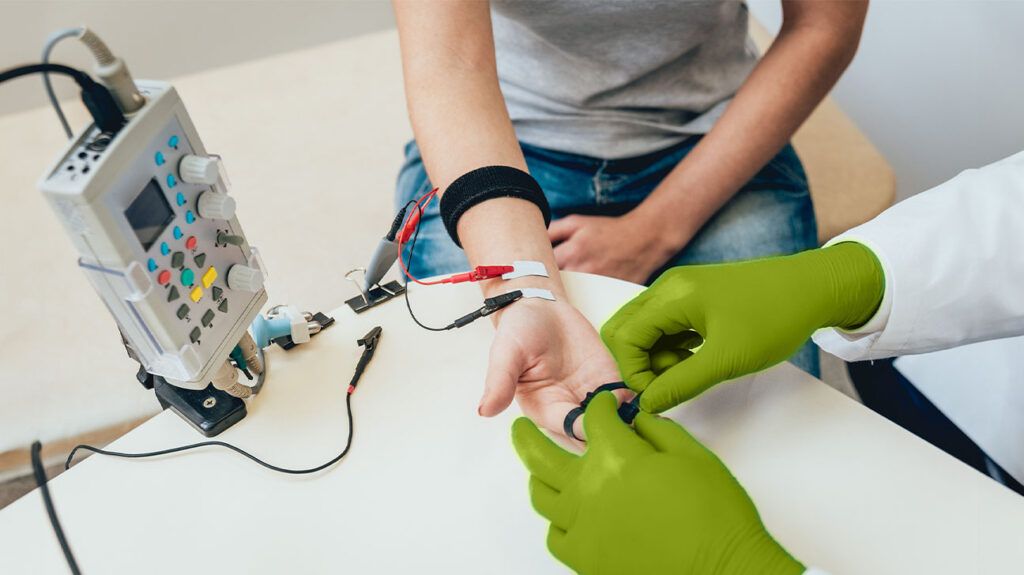Electromyography (EMG) is a diagnostic test that shows the electrical signals the muscles make when a person is using them and when they are at rest. It does not help doctors diagnose multiple sclerosis (MS).
Multiple sclerosis (MS) is a progressive condition in which the immune system attacks the brain and spinal cord, damaging the protective covering of nerves known as myelin.
The condition can lead to different symptoms for every person with it. However, numbness, tingling, muscle weakness, and paralysis may be symptoms for some people with MS.
An EMG can help a doctor understand how a person’s muscles and nerves interact. It may be useful in ruling out other possible causes of symptoms that may also occur with MS.
Read on to learn more about EMG and MS.

No research or guidelines currently suggest an EMG is useful as a direct test for MS.
However, some doctors may use it to rule out other conditions that cause some similar symptoms to those of MS. These might include:
As MS can be complex to diagnose, ruling out conditions with similar symptoms using an EMG can support an MS diagnosis alongside more conventional tests.
Learn more about conditions that can appear similar to MS.
The procedure during an EMG test is as follows:
- The individual will sit or lie on a table or bed.
- The medical professional will clean the skin over the muscle being tested.
- They will place a needle electrode into the muscle. A needle electrode is a special wire a mild electric current flows through. The individual may experience slight pain or discomfort during electrode insertion.
- The machine records the muscle activity while the muscle is at rest.
- The individual then contracts the muscle slowly and steadily. The machine will record this activity.
- The medical professional may reposition the electrode to record activity in different muscles.
- The machine will record and show the electrical activity on a video screen. The machine displays the activity as wavy and spiky lines. The machine may also record and send the activity to an audio speaker. The individual may hear popping sounds when contracting the muscle.
Often, the medical professional will conduct a test called a nerve conduction study during the same appointment. However, the nerve conduction study will happen first. This study stimulates the nerves to show how the muscle reacts.
Performing both tests during the same appointment can help a doctor decide whether the symptoms are occurring due to a muscle disorder or a nerve problem.
A doctor may recommend an EMG for people who experience the following symptoms:
- ongoing muscle weakness
- numbness or tingling in the hands, feet, face, legs, or arms
- cramps
- spasms
- twitching
- paralysis
MS can cause these symptoms at
However, research is ongoing as to whether EMG might be useful for identifying MS directly in the future. For example, one
EMG results that fall outside of a typical range can point to several possible problems that can affect the nerves and muscles, including:
- Amyotrophic lateral sclerosis (ALS): This is a progressive disorder that attacks nerve cells in the brain and spinal cord and affects all the muscles used for movement, speech, eating, and breathing.
- Carpal tunnel syndrome: Carpal tunnel syndrome affects nerves in the hands and arms.
- Charcot-Marie-Tooth disease: This is an inherited disorder that causes nerve damage, mainly in the arms and legs.
- Guillain-Barré syndrome: This is an autoimmune disorder that attacks the nerves, causing numbness, tingling, and paralysis.
- Herniated disk: A herniated disk can cause pain and numbness due to spinal damage.
- Muscular dystrophy: This is a condition that passes from parents to children and significantly impairs muscle structure and function.
- Myasthenia gravis: This is a rare disorder linked to muscle fatigue and weakness.
A doctor will likely carry out further tests to confirm these diagnoses.
Before an EMG, some preparations might be necessary. These include washing off any moisturizers, lotions, and fake tans from the legs, arms, and hands. Loose clothing is also advisable for the day of the testing.
However, people do not need to change what they eat or drink. They can take any regular medications as usual.
People should let the physician know if they:
- have a pacemaker
- have an implantable cardioverter defibrillator (ICD)
- have any implanted device that uses batteries
- are taking some blood thinners, such as warfarin
- take antiplatelet medications
- have recently had a Botox injection
An EMG is generally a low risk test.
Some slight pain or cramping might occur during the test. A person might also feel some tingling during a nerve conduction study, which is a test that often happens before the EMG.
At present, a doctor would refer an individual for several tests to confirm an MS diagnosis. These can
- Magnetic resonance imaging (MRI): This can show whether MS has caused lesions in the brain or central nervous system.
- Lumbar puncture or spinal tap: Analysis of the cerebrospinal fluid (CSF) may show proteins or chemical signs of inflammation that show MS activity.
- Evoked potential tests: These use electrodes to test nerve system reactions with electrical signals.
These would support a full physical examination and medical history in reaching an MS diagnosis.
Learn more about how doctors diagnose MS.
The main role of electromyography (EMG) in a multiple sclerosis (MS) diagnosis is to rule out other conditions that cause numbness, tingling, cramps, twitches, and muscle paralysis. MS does not show up on an EMG, but research has found that people with MS may show certain results and patterns on an EMG.
If a doctor suspects MS, they will likely order other tests, such as an MRI, lumbar puncture, and evoked potential tests, to confirm the diagnosis.
